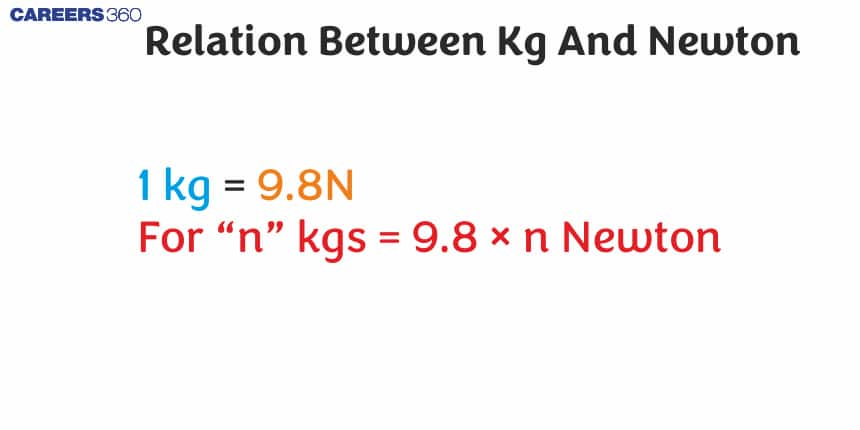Relation Between Kg And Newton
Every physical entity can be measured in a variety of ways in physics. Without breaking the principles of physics or nature, every unit can be related to one another through unit conversions. One Newton is equal to the force of 100,000 dynes.
The SI unit of force is Newton, and the SI unit of mass is the kilogram. Force is directly proportional to the mass of the object on which force is exerted, according to Newton's Second Law of Motion. As a result, we may conclude that Newton and Kg are directly proportional to each other; therefore any change in the unit of force in the Newton unit will result in a change in the unit of mass in Kg to newtons, while the acceleration remains constant.
This Story also Contains
- Define 1 kg
- Define 1 Newton
- Relation between kg and Newton

Also, read
Define 1 kg
1 kilogram (kg) is the SI unit of mass. It is defined as the mass of a standard reference kept at the International Bureau of Weights and Measures (BIPM) in France.
1 kg is the standard unit used to measure how heavy an object is.
Define 1 Newton
1 Newton (N) is the SI unit of force. It is defined as the force that produces an acceleration of 1 meter per second ${ }^{\mathbf{2}}\left(\mathbf{1 ~ m} / \mathbf{s}^{\mathbf{2}}\right)$ in a body of mass $\mathbf{1}$ kilogram ( $\mathbf{1 ~ k g}$ ).
$1 \mathrm{~N}=1 \mathrm{~kg} \cdot 1 \mathrm{~m} / \mathrm{s}^2$
A force of 1 Newton is enough to accelerate a 1 kg object at the rate of $1 \mathrm{~m} / \mathrm{s}^2$.
Relation between kg and Newton
The kilogram (kg) is a unit of mass, while the Newton (N) is a unit of force. They are related through Newton's second law of motion:
$
F=m \cdot a
$
Where:
- $F=$ force in Newtons (N)
- $m=$ mass in kilograms (kg)
- $a=$ acceleration in meters per second squared $\left(\mathrm{m} / \mathrm{s}^2\right)$
For example, if a body of mass $\mathbf{1} \mathbf{~ k g}$ is accelerated at $\mathbf{1} \mathbf{~ m} / \mathbf{s}^{\mathbf{2}}$, the force applied is $\mathbf{1} \mathbf{N}$.
1 Newton is the force required to accelerate 1 kg of mass at $1 \mathrm{~m} / \mathrm{s}^2$.
The relation between kg and newton can be mathematically expressed using
Newton's second law of motion is as follows-
$
1 N=k g \times \frac{m}{s^2}
$
Where,
- N is the force in Newton.
- kg is the mass in kilograms.
- $m$ is the distance traveled in meters.
- $s$ is the time duration in seconds.
Thus 1 newton is equal to the force needed to accelerate 1 kg of mass at the rate of 1 $\mathrm{m} / \mathrm{s}^2$.
Refer the table below for kg to newton and newton to kg values.
| Kg to Newton | 1 kg = 9.81 N |
| Newton to Kg | 1N = 0.1019 kg |
Related Topics
Frequently Asked Questions (FAQs)
The SI unit of force is Newton. It is defined as the force required to accelerate a 1 kilogram (1kg) item by 1 meter per second squared in the direction of applied force. 1N equals 10^5 Dyne in the CGS system. In the CGS system, a dyne is a unit of force.
The physical quantities of mass and weight are not the same. The amount of substance in an object is its mass, and the force imposed on the body by gravity is its weight.
If we know that 1kg force Equals 9.81N, we may calculate:
5 kilogram-force = 5 x 9.81 kilograms = 49.05 kilograms
As a result, 49.05N equals 5Kg force.
In physics, there are seven fundamental units, and Kg is one of them. (Fundamental units are quantities that stand-alone; all other units are derived from them.) Kilogram is abbreviated as Kg.
One kilo is about equal to 1000 grams. In metric systems, the kg is one of the most basic units.